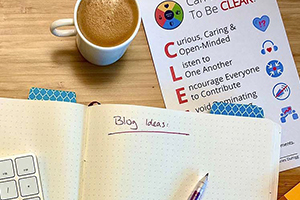
About 8 years ago I was sitting in a room with one of the teams I’d managed.
If a stranger had walked in, they would think we just found out someone died.
Every single person on this 8-person team: every engineer, every business analyst, and our product manager (who had WAY too many projects) looked completely burnt out and frustrated. Some were leaning forward in exhaustion. Some leaned back in the bright yellow chairs, looking to the ceiling like their head was about to explode.
Well, every person but one - New Guy.
New Guy had only been with us about a month but had worked on another team prior at the same company. He had a face of pure regret.
And there I am, The Boss, unable to remove the massive roadblock that faced them.
My team was working on a product that was heavily dependent on other teams, and one specific team - the most crucial one - was led by a tyrant.
Let’s call this tyrant Charlie.
Charlie is what I’d like to call an Unintentional Tyrant. He was Principal Architect who was never, ever told “no,” so he did whatever he wanted and “led” his entire team.
Which meant he was the ONLY person on his team who could approve pull requests.
Which meant when he was on vacation, we waited.
Which meant when he was sick, we waited.
Which meant that nothing got done on time, and he could take as long as he wanted.
My team and other teams were justifiably very frustrated. There was a massive blocker in all the work we were trying to get done, and it felt like they no longer had control over their own work - there was a Supreme Being who got to call all the shots.
I encouraged the team to talk with Charlie. They all told me they did, and he always seemed calm, collected and would say “yeah, sorry for the delay. I’ll get to it soon. I can’t let just anyone approve PRs, it’s a complex domain.”
Nothing ever changed.
So, I went to my boss.
To my shock and disappointment, I was told nothing could be done.
“He’s really smart, and he’s been here for over 10 years. We really don’t want to rock the boat.”
And so, here we are, brainstorming about a problem we had tried to solve a million times. I don’t know why I thought this time could be different - but it HAD to be different.
And all of us felt helpless.
“Do you know how many people have quit because of Charlie?” one of the engineers moaned into her hands. “So many. I can’t lie, I’m starting to think about looking, too.”
“Me too,” another said.
“Maybe we haven’t been telling the right story to leaders,” New Guy said out of nowhere.
An engineer scoffed. “Uh, we’ve brought up Charlie to lots of people. No one does anything.”
“Well, that’s kinda what I mean,” New Guy said. “What if we didn’t make this about Charlie, but made it about the process?”
I perked up a little. “Yes. The process.”
“But other teams don’t have this problem,” the QA chimed in. The only ones who have this problem are the ones who work with Charlie.”
“Right!” New Guy said, sitting up straight. “We all have data available in ADO about how long this is taking us, and how much it costs us. If we aren’t making it about Charlie we can make it about everything around it.”
The air of apathy in the room was still thick. I knew this wouldn’t change things overnight - but I knew that New Guy had just come up with a great idea.
And guess what?
We DID get them to change the process.
But how?
- We identified a different approach. Don’t focus on the problematic person, focus on the problem.
- We changed up our Team Working Agreement. We agreed to be patient AND keep our eyes on the prize. We knew this wouldn’t happen fast. We also agreed to be honest with one another when we were hitting a wall with the issue, which required psychological safety on the team.
- We found Helpers. Once my boss and my boss’s boss understood our approach and recognized that we would be a much more effective team with this problem solved (and we could reduce turnover), they agreed to help. They started having conversations with other leaders in that area that were no longer specific to Charlie, but about efficiency.
- We got data to tell our stories. Good data is powerful. Great data that is specific to the issue you’re trying to resolve is a game changer.
- We ALL had to believe this was possible. There were some folks on the team who really didn’t believe in the plan. They chose to leave the team. It was okay that they were burnt out and didn’t want to keep going. In our agreement, we all had to be on board. Additionally, since we had been actively practicing building trust and psychological safety so we were unafraid to speak up honestly, we were able to have real conversations.
So, what happened? Did anything change?
Charlie finally delegated to someone else on the team. Someone who also was a little more personable and approachable. Standups went from looking like a funeral procession to one with laughter, and - were much more efficient.
You cannot change problems in your organization overnight. But you can make changes. Sometimes it takes fresh perspectives. The role you play in an organizational chart isn’t nearly as important as being able to see past politics and see potential for change.




